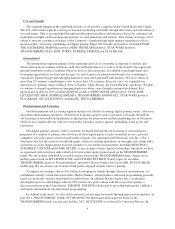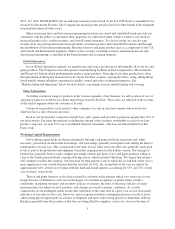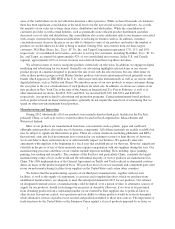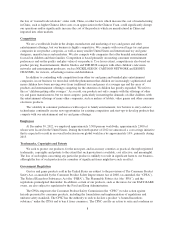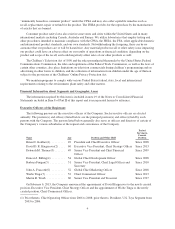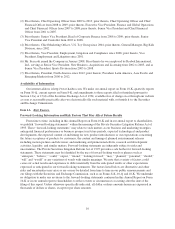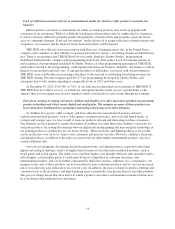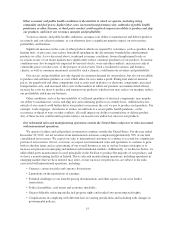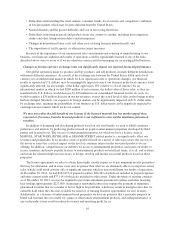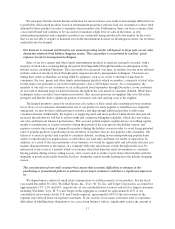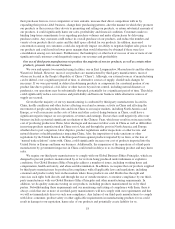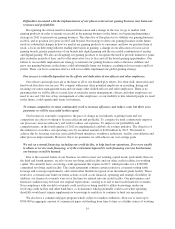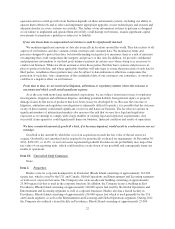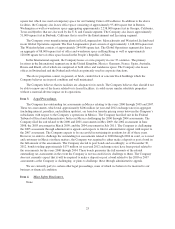Hasbro 2012 Annual Report Download - page 24
Download and view the complete annual report
Please find page 24 of the 2012 Hasbro annual report below. You can navigate through the pages in the report by either clicking on the pages listed below, or by using the keyword search tool below to find specific information within the annual report.Lack of sufficient consumer interest in entertainment media for which we offer products can harm our
business.
Motion pictures, television or other media for which we develop products may not be as popular with
consumers as we anticipated. While it is difficult to anticipate what products may be sought after by consumers,
it can be even more difficult to properly predict the popularity of media efforts and properties given the broad
array of competing offerings. If our and our partners’ media efforts fail to garner sufficient consumer interest and
acceptance, our revenues and the financial return from such efforts will be harmed.
THE HUB, our cable television joint venture with Discovery Communications, Inc. in the United States,
competes with a number of other children’s television networks for viewers, advertising revenue and distribution
fees. There is no guarantee that THE HUB will be successful. Similarly, Hasbro Studios’ programming
distributed internationally competes with programming from many other parties. Lack of consumer interest in
and acceptance of programming developed by Hasbro Studios, or other programming appearing on THE HUB,
and products related to that programming, could significantly harm our business. Similarly, our business could be
harmed by greater than expected costs, or unexpected delays or difficulties, associated with our investment in
THE HUB, such as difficulties in increasing subscribers to the network or in building advertising revenues for
THE HUB. During 2012 the Company paid $59,277 for programming developed by Hasbro Studios and
anticipates that it will continue spending at comparable levels in 2013 and future years.
At December 30, 2012, $330,746, or 7.6%, of our total assets represented our investment in THE HUB. If
THE HUB does not achieve success, or if there are subsequent declines in the success or profitability of the
channel, then our investment may become impaired, which could result in a write-down through net earnings.
Part of our strategy to remain relevant to children and families is to offer innovative products incorporating
greater technology and which marry digital and analog play. The margins on many of these products are
lower than more traditional toys and games and such products may have short lifespans.
As children have grown “older younger” and have otherwise become interested in more and more
sophisticated and adult products, such as video games, consumer electronics and social and digital media, at
younger and younger ages, we have sought to keep our products relevant and interesting for these consumers.
One initiative we have pursued to capture the interest of children is to offer innovative children’s electronic toy
and game products. Increasing the marriage between digital and analog gaming and increasing the technology in
our gaming products is another key for our future strategy. These electronic and digital products, if successful,
can be an effective way for us to connect with consumers and increase our sales. However, children’s electronic
and digital products, in addition to the risks associated with our other family entertainment products, also face
certain additional risks.
Our costs for designing, developing and producing electronic and digital products, or products that marry
digital and analog technology, tend to be higher than for many of our other more traditional products, such as
board games and action figures. The ability to recoup these higher costs through sufficient sales quantities and to
reflect higher costs in higher prices is constrained by heavy competition in consumer electronics and
entertainment products, and can be further constrained by difficult economic conditions. As a consequence, our
margins on the sales of these products can be lower than for more traditional products and we can face increased
risk of not achieving sales sufficient to recover our costs. In addition, the pace of change in product offerings and
consumer tastes in the electronics and digital gaming areas is potentially even greater than for our other products.
This pace of change means that the window in which a product can achieve and maintain consumer interest may
be even shorter than traditional toys and games.
14


